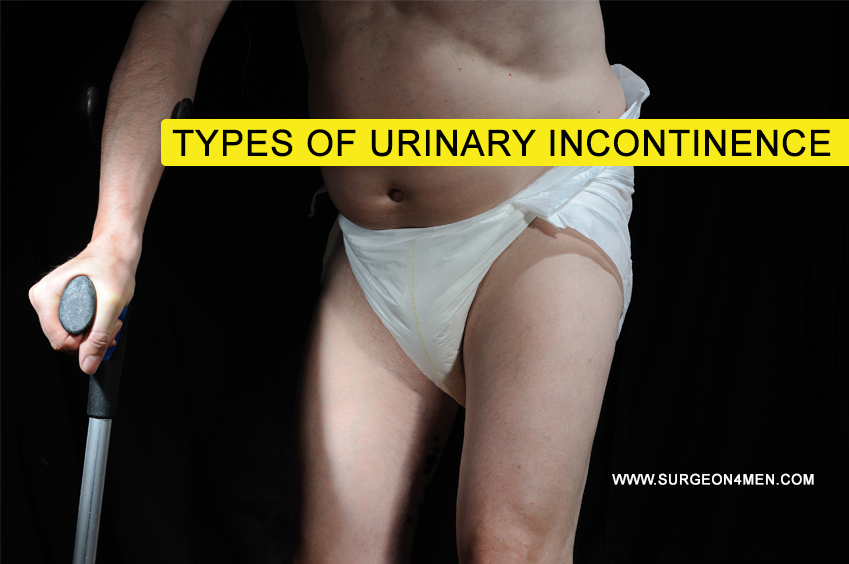Types Of Urinary Incontinence
Urinary incontinence refers to overflow or dribbling of urine despite a voluntary effort to hold/ constrict the urinary sphincters. Incontinence of urine not only affects your physical health, but can also influence your capacity to engage in normal day-to-day activities.
Depending upon the cause of dysfunction, urinary incontinence can be divided into following types;
1. Overactive Bladder Or Urge Incontinence:
The leakage due to overpowering and uncontrollable urge to urinate is referred to as overactive bladder (OAB) or urge incontinence. In certain individuals, bladder muscles receives contraction message long before a person is actually prepared to urinate, such a situation can lead to overactive bladder. In all such cases, the detrusor muscle of bladder loses its flexibility and become stiff. Stretching of bladder muscles further evokes the need to urinate, which is perceived as urinary urgency. Urologist often term this condition as lower urinary tract symptoms (LUTS).
About 16.6% Americans have OAB and 12.2 million suffer from severe cases of OAB, which is defined as “Wet” in which there is accidental urine leakage. Overactive bladder is not associated with weak bladder or high intake of fluids. Although it is not always associated with physiological aging, it has been observed that the risk of developing overactive bladder increases with age. Among men 60 years or older, about 5% suffers from overactive bladder incontinence. According to a new study published in the journal Diabetes Care, poorly managed, chronic diabetes is also very frequently linked with LUTS and nocturia.
2. Stress Urinary Incontinence:
Physical activities such as lifting, exercise, coughing or sneezing can increase the intra-abdominal pressure. Under normal circumstances, urinary sphincters are capable of holding the urine by tightly constricting the sphincters; however, in individuals who have stress incontinence, any activity that increases the intraabdominal pressure can lead to leakage of urine.
Sometimes people suffer from a combination of these two clinical varieties of incontinence; termed as mixed incontinence. Usually this happens after the surgery of prostate cancer but sometimes it can also happen due to trans-urethral prostate surgery or radiotherapy of prostate cancer.
3. Orgasmuria:
In some cases, people feel the urge to urinate during intercourse, such incontinence is termed as orgasmuria. It can hinder the quality of sexual act, as many males becomes anxious or embarrassed. This condition is observed in 30% of men who have undergone a surgery for the management of prostate cancer.
Common Causes Of Urinary Incontinence
Most frequently reported causes of urinary incontinence are:
- Benign prostate hypertrophy (enlargement of prostate)
- Recurrent episodes of urinary tract infection
- Chronic inflammation or infection of prostate
- Degeneration of bladder
- Chronic and poorly managed diabetes
- Parkinson’s disease
- Detrusor external sphincter dyssynergia, observed in people with multiple sclerosis and spinal cord injury
- Sometimes it can be due to multiple factors or an unknown cause
What Are Some Risk Factors That May Aggravate The Risk Of Developing Urinary Incontinence?
Urinary sphincters are the bundles of smooth muscles that squeeze and keeps the urethra close at all times. If the sphincters get damaged, they lose the ability to function properly (i.e. controlling the urinary flow); thereby leading to leakage or incontinence of urine. The sphincters may get damage due to surgery (especially surgical procedures involving prostate, urinary bladder, urethra etc.), malignancy of inguinal organs or severe trauma or injury in this region. In some cases, incontinence is also seen as a complication of certain drugs or some neurological diseases.
Speak to your doctor if urinary incontinence is compromising your quality of life. Clinical studies indicates that most patients can achieve absolute relief from the disturbing symptoms with minimal treatment and lifestyle modification.
References:
1. Breyer, B. N., Phelan, S., Hogan, P. E., Rosen, R. C., Kitabchi, A. E., Wing, R. R., … & Look AHEAD Research Group. (2014). Intensive lifestyle intervention reduces urinary incontinence in overweight/obese men with type 2 diabetes: results from the Look AHEAD trial. The Journal of urology, 192(1), 144-149.
2. D’Silva, K. A., Dahm, P., & Wong, C. L. (2014). Does this man with lower urinary tract symptoms have bladder outlet obstruction?: The Rational Clinical Examination: a systematic review. Jama, 312(5).
3. Coyne, K. S., Sexton, C. C., Bell, J. A., Thompson, C. L., Dmochowski, R., Bavendam, T., … & Quentin Clemens, J. (2013). The prevalence of lower urinary tract symptoms (LUTS) and overactive bladder (OAB) by racial/ethnic group and age: Results from OAB‐POLL. Neurourology and urodynamics, 32(3), 230-237.

